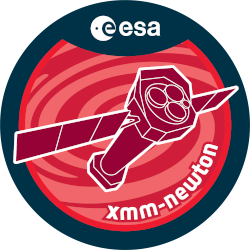

| Proposal ID | 069060 |
| Title | A new heavyweight champion for stellar mass BHs? XMM and Chandra investigate |
| Download Data Associated to the proposal | https://nxsa.esac.esa.int/nxsa-sl/servlet/data-action-aio?obsno=0690600401 |
| DOI | https://doi.org/10.5270/esa-4dmhau2 |
| Principal Investigator, PI | Dr Robin Barnard |
| Abstract | The X-ray source associated with the M31 globular cluster Bo~135 (hereafter XBo135) may contain the largest stellar mass black hole (BH) to date. It has beenobserved several times with Chandra and XMM-Newton, and has always exhibitedemission spectra characteristic of the BH low state. XBo 135 exhibited thisbehaviour at ~4-6E+38 erg/s, suggesting a primary mass >50 Solar masses.Possible formation scenarios include stellar mergers in the cluster center, orthe direct collapse of a metal poor high mass star. We request 120 ks ofXMM-Newton time to investigate the metalicity, and a 5 ks Chandra pointing toaccurately locate the source. These observations will test the feasibility ofthese scenarios; in particular, a high metalicity will rule out direct collapse. |
| Publications |
|
| Instrument | EMOS1, EMOS2, EPN, OM, RGS1, RGS2 |
| Temporal Coverage | 2012-06-26T05:23:25Z/2012-06-27T15:22:40Z |
| Version | 17.56_20190403_1200 |
| Mission Description | The European Space Agencys (ESA) X-ray Multi-Mirror Mission (XMM-Newton) was launched by an Ariane 504 on December 10th 1999. XMM-Newton is ESAs second cornerstone of the Horizon 2000 Science Programme. It carries 3 high throughput X-ray telescopes with an unprecedented effective area, and an optical monitor, the first flown on a X-ray observatory. The large collecting area and ability to make long uninterrupted exposures provide highly sensitive observations. Since Earths atmosphere blocks out all X-rays, only a telescope in space can detect and study celestial X-ray sources. The XMM-Newton mission is helping scientists to solve a number of cosmic mysteries, ranging from the enigmatic black holes to the origins of the Universe itself. Observing time on XMM-Newton is being made available to the scientific community, applying for observational periods on a competitive basis. |
| Creator Contact | https://www.cosmos.esa.int/web/xmm-newton/xmm-newton-helpdesk |
| Date Published | 2013-07-19T00:00:00Z |
| Last Update | 2025-08-04 |
| Keywords | "XMM", "cluster center", "heavyweight champion", "stellar mergers", "XMM-Newton", "formation scenarios", "solar masses", "M31", "emission spectra characteristic", "xray source", "xmm newton", "mass star", "primary mass", "stellar mass bhs", "bh low", "xmm newton time", "xbo 135" |
| Publisher And Registrant | European Space Agency |
| Credit Guidelines | European Space Agency, Dr Robin Barnard, 2013, 'A new heavyweight champion for stellar mass BHs? XMM and Chandra investigate', 17.56_20190403_1200, European Space Agency, https://doi.org/10.5270/esa-4dmhau2 |